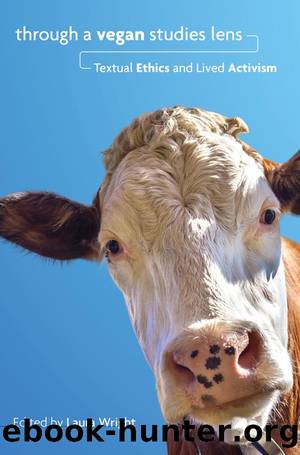Through a Vegan Studies Lens by Laura Wright

Author:Laura Wright [Wright, Laura]
Language: eng
Format: epub
ISBN: 9781948908115
Barnesnoble:
Publisher: University of Nevada Press
Published: 2019-02-20T00:00:00+00:00
END NOTES
1. A more detailed example is a recently published book of essays titled Cosmopolitan Animals (2015), which opens with the declaration that nonhuman organisms should be viewed alongside humans as experiencing subjects in contemporary contexts. Drawing on the Greek origins of the term âcosmopolitan,â Kaori Nagai asserts in this collectionâs introduction that âwe have to start by redefining âa cosmosâ as a tangled-up âknot of species coshaping one another,â rather than as an orderly âgood worldââ (2).
2. Twineâs research was conducted in the United Kingdom, where poverty and food shortage are comparatively uncommon in relation to developing countries. Such findings may not be true for other regions.
3. Coined by Kimberlé Crenshaw to highlight the disjuncture between mainstream (white) feminism and the civil rights movement, âintersectionalityâ objects to approaching rights struggles as singular issues in a âtop-down approachâ (Crenshaw 167). The term has since been used to show that one must consider how subjects can fall victim to various disadvantages due to ableist, classist, heterosexist, racist, or sexist prejudices.
4. During a conference titled Towards a Vegan Theory hosted by the University of Oxford in May 2016, many delegates returned to two prominent problems. The first was that the movementâs relative youth means that it remains unclear what exactly vegan studies isâor, rather, what it could grow to become. Second, scholars alluded to the dangers of âacademic colonisationâ in animal rights circlesâa potentially ironic observation, given that the event took place at one of the worldâs most prestigious universities.
5. In South Africa, the term âcolouredâ is used to refer to people of mixed ethnic descentâparticularly those whose ancestors were South- and Southeast Asian slaves. Even in the post-transitional democracy, such groups mostly embrace this term, viewing it as a source of âmythologisedâ pride (Wicomb, âFive Afrikaner Textsâ 363).
6. Boerewors is an inexpensive form of coiled sausage which evokes references as disparate as Afrikaner nationalism, coloured cultural identity, and (in Wicombâs fiction) James Joyceâs Ulysses (Driver 101).
7. Roosterbrood is traditional bread made using activated yeast, similar in consistency to sourdough.
8. The gesture also serves to implicitly highlight the mammalian connection between cows and humans: both species only produce milk to feed their young. This fact is often unaddressed by corporatized dairy farms.
9. Driver notes that in Wicombâs earlier fiction, coloured characters often refer to traditional dishes with the collective term âons kosâ (105; my italics), meaning âour food.â
10. Merciaâs reflection on interconnected species calls to mind earlier acoustic-phonetic effects, such as Jakeâs repetition of the phrase âBu-ullshitâ (15â16), or the young Sylvieâs recurring concern that she is known as a âloose gooseâ (195â97).
11. Earlier in the narrative the protagonist refuses to be called by the nickname Mercy after she learns that the name Mercia refers to an English-speaking region of South Africa that was inhabited by Namaqua people (26). Therefore, it is dubious that Sylvie intends this word to be a fond diminutive.
Download
This site does not store any files on its server. We only index and link to content provided by other sites. Please contact the content providers to delete copyright contents if any and email us, we'll remove relevant links or contents immediately.
The Lonely City by Olivia Laing(4768)
Animal Frequency by Melissa Alvarez(4424)
All Creatures Great and Small by James Herriot(4267)
Walking by Henry David Thoreau(3921)
Exit West by Mohsin Hamid(3794)
Origin Story: A Big History of Everything by David Christian(3665)
COSMOS by Carl Sagan(3585)
How to Read Water: Clues and Patterns from Puddles to the Sea (Natural Navigation) by Tristan Gooley(3430)
Hedgerow by John Wright(3314)
How to Read Nature by Tristan Gooley(3290)
The Inner Life of Animals by Peter Wohlleben(3284)
How to Do Nothing by Jenny Odell(3263)
Project Animal Farm: An Accidental Journey into the Secret World of Farming and the Truth About Our Food by Sonia Faruqi(3189)
Origin Story by David Christian(3170)
Water by Ian Miller(3155)
A Forest Journey by John Perlin(3042)
The Plant Messiah by Carlos Magdalena(2900)
A Wilder Time by William E. Glassley(2833)
Forests: A Very Short Introduction by Jaboury Ghazoul(2814)
